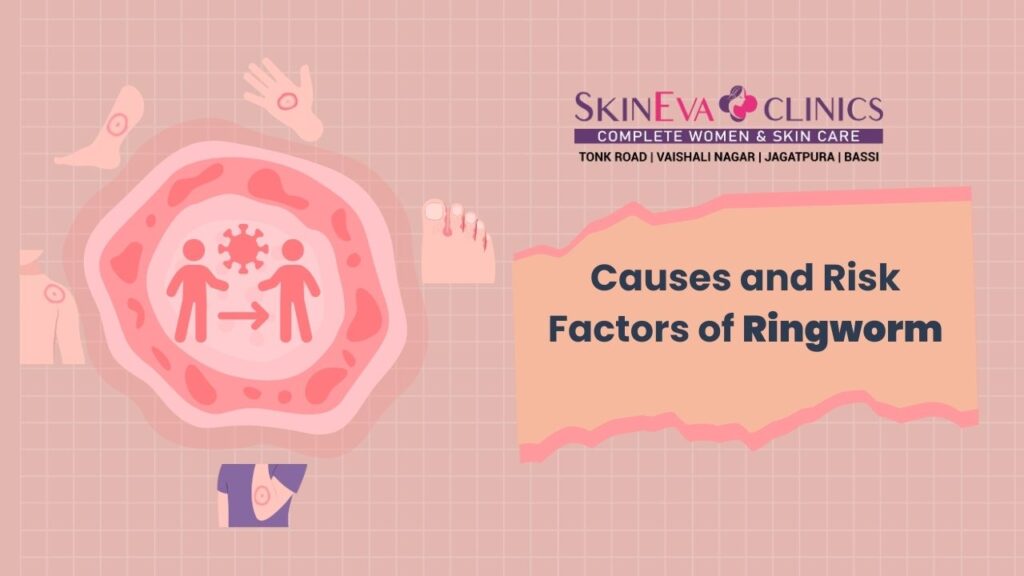Causes and Risk Factors of Ringworm

Ringworm is not related to worms but to fungi known as dermatophytes. This common skin infection can affect anyone, regardless of age or gender, and often shows up as itchy, circular patches on the skin, scalp, or nails. While many people think of ringworm as a minor problem, the truth is that it spreads quickly and can become persistent if the root causes and contributing factors are not understood. By knowing what triggers ringworm and who is at higher risk, individuals can take timely steps to prevent infection and manage it effectively.
Causes of Ringworm
Ringworm isn’t caused by worms but by fungi called dermatophytes, which thrive on keratin in skin, hair, and nails.
Let’s break down the main causes of ringworm and how it spreads:
1. Human-to-Human Contact
One of the main ways it spreads is direct skin-to-skin contact.
- If someone has ringworm and you touch the affected area, the fungi can transfer to your skin.
- This is especially common in children, schools, gyms, or households where close contact happens often.
- Even sharing personal items like towels, clothes, combs, or bedding can pass the infection.
2. Animal-to-Human Contact
Animals can also be carriers of ringworm — and they don’t always show obvious symptoms.
- Cats and dogs are the most common sources, but farm animals like cows, goats, and horses can also carry the fungi.
- If you pet, groom, or cuddle an infected animal, the fungi can transfer onto your skin.
- Children are at higher risk because they often snuggle and interact closely with household pets.
Tip: If your pet has patchy hair loss or scaly skin, it might be a sign of ringworm. A vet visit is a must.
3. Object-to-Human (Indirect Contact)
Ringworm fungi can survive on objects and surfaces for days or even weeks. This means you can catch it without touching a person or animal directly.
- Items like hairbrushes, hats, towels, gym clothes, or sports equipment can harbor the fungi.
- Shared spaces such as locker rooms, public showers, and swimming pool areas are high-risk because they stay damp and are used by many people.
- Going barefoot in public places makes it easier for fungi to cling to the skin, especially between the toes.
4. Soil-to-Human Contact
Although less common, some species of fungi live naturally in the soil.
- People who garden, farm, or play in the dirt without gloves or shoes can sometimes pick up the infection.
- Prolonged contact with contaminated soil is usually needed for the fungi to transfer.
5. Why Ringworm Spreads So Easily
The fungi behind ringworm are extremely good at surviving outside the body. They can linger on surfaces, clothing, or animal fur, waiting for the right opportunity to infect. Add warm, moist conditions (like sweaty skin or damp clothes), and the fungi multiply quickly.
Risk Factors of Ringworm – Who Is More Likely to Get It?
Ringworm can affect anyone, but certain lifestyles and environments create perfect conditions that increase the risk of developing this infection.
Below are the leading risk factors that increase ringworm infection chances:
1. Living in Warm and Humid Climates
Ringworm-causing fungi thrive in hot, damp conditions.
- People living in tropical or humid regions are naturally at higher risk.
- Excessive sweating in such climates only makes it easier for fungi to grow on the skin.
2. Excessive Sweating and Damp Skin
If you sweat a lot (a condition known as hyperhidrosis), you’re more vulnerable.
- Wearing damp or sweaty clothes for extended periods encourages fungal growth on the skin.
- People in sports or physically intense jobs commonly experience this issue.
3. Close-Contact Sports
Sports like wrestling, rugby, and martial arts involve direct skin-to-skin contact.
- Because of this, fungi can spread quickly from person to person.
- In wrestlers, ringworm has a specific name — tinea gladiatorum.
4. Shared Facilities and Items
Ringworm loves places where many people gather and share things.
- Gyms, pools, locker rooms, and communal showers are all high-risk environments.
- Sharing items such as towels, clothing, bedding, combs, or sports equipment increases the chances of infection.
5. Contact with Infected Animals
Pets like cats and dogs, as well as farm animals such as cows and goats, can carry and spread the fungi.
- Kids are more prone because they spend a lot of time playing closely with pets.
- Even grooming or touching an infected animal is enough to pass the infection.
6. Weakened Immune System
Your immune system plays a big role in keeping fungi under control.
- Individuals with weak immune systems, such as those with diabetes, HIV/AIDS, or on chemotherapy, are more at risk.
- For them, ringworm infections may be more frequent, more severe, and harder to treat.
7. Pre-existing Skin Problems or Injuries
Any break in the skin — whether from cuts, scrapes, eczema, or psoriasis — makes it easier for fungi to enter and cause infection.
8. Poor Hygiene Habits
Not keeping skin clean and dry can encourage fungal growth.
- Staying in damp clothing, not washing after workouts, or sharing unwashed personal items makes ringworm more likely.
9. Tight or Non-Breathable Clothing
Clothing that rubs against the skin and traps sweat — like tight shoes, socks, or gym wear — creates the ideal moist, warm environment fungi love.
10. Children and Overcrowded Living Conditions
- Children are especially prone to scalp ringworm (tinea capitis) since they often share combs, hats, or play in close contact.
- Overcrowded housing or community living (such as hostels, military housing, or dormitories) also increases the risk of spreading infections quickly.
Conclusion
Ringworm may be a common fungal infection, but it is far from insignificant. Understanding its causes—ranging from direct contact with infected individuals or pets to environmental exposure—and recognizing the risk factors such as weakened immunity, poor hygiene, or humid climates, are crucial in breaking the cycle of recurrence. With proper awareness, early treatment, and preventive measures, anyone can protect themselves and their families from this contagious condition.



Leave a Comment